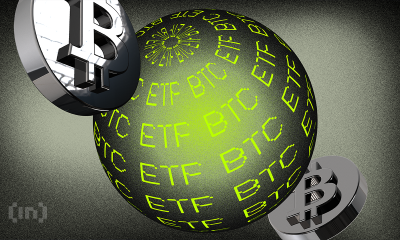Bitcoin
Bitcoin Recovers After CPI Data Drop, But Is It Sustainable?

Following the release of the Consumer Price Index (CPI) data for the month of August, the Bitcoin price saw a major rebound. From trending around the $55,000 level, the price has since recovered and bulls continue to fight to turn the $58,000 resistance into support. However, despite the strength being shown by Bitcoin during this time, there is still skepticism surrounding the recovery. Mainly, the questions have been on whether this is a true recovery or if the BTC price is headed for further decline.
CPI Brings Fresh Hope
The Consumer Price Index (CPI) data represents how much consumers are paying for consumer goods and services at different times. Basically, it calculates the change in the price of these goods and services, showing whether purchasing power has gone up on down.
For the month of August, the CPI data came in lower than expected, making it a positive for the financial markets. According to reports, instead of the 2.6% annual increase that experts expect, the CPI data came out to a 2.5% increase annually.
This comes as the inflation data rose higher than the forecasted month-on-month 0.2% and came out to 0.3%. However, it has not affected the positivity brought about by the CPI data, especially given that the 2.5% increase in the lowest recorded levels since February 2021, so more than three years.
The Bitcoin price immediately reacted positively to the CPI data release. It jumped around 3% in a single day, retesting the $58,000 level not too long after. However, with the positive sentiment brought about by the CPI data already waning, the price could see a drawdown from here.
Bitcoin And Crypto Market Still In Fear
Although there has ben a recovery in the Bitcoin and crypto market sentiment, is still far from a perfect situation for a price surge. From last week to this week, the crypto Fear & Greed Index has fluctuated between 22 and 37 on the scale. This means that sentiment is still firmly in the bearish territory.
During times like these, inflows into the market are often minimum as investors figure out their next move. This could explain why the Bitcoin price has been trading in a very tight range below $60,000 since then. However, if the bulls continue to dominate, then reclaiming support above $60,000 could be the next stop.
With Spot Bitcoin outflows still continuing, and BTC miners selling a large chunk of their holdings, this decline could continue. In that case, then the Bitcoin price could be falling toward $50,000 again.
Featured image created with Dall.E, chart from Tradingview.com
Bitcoin
Why ETF Issuers are Buying Bitcoin Despite Recession Fears
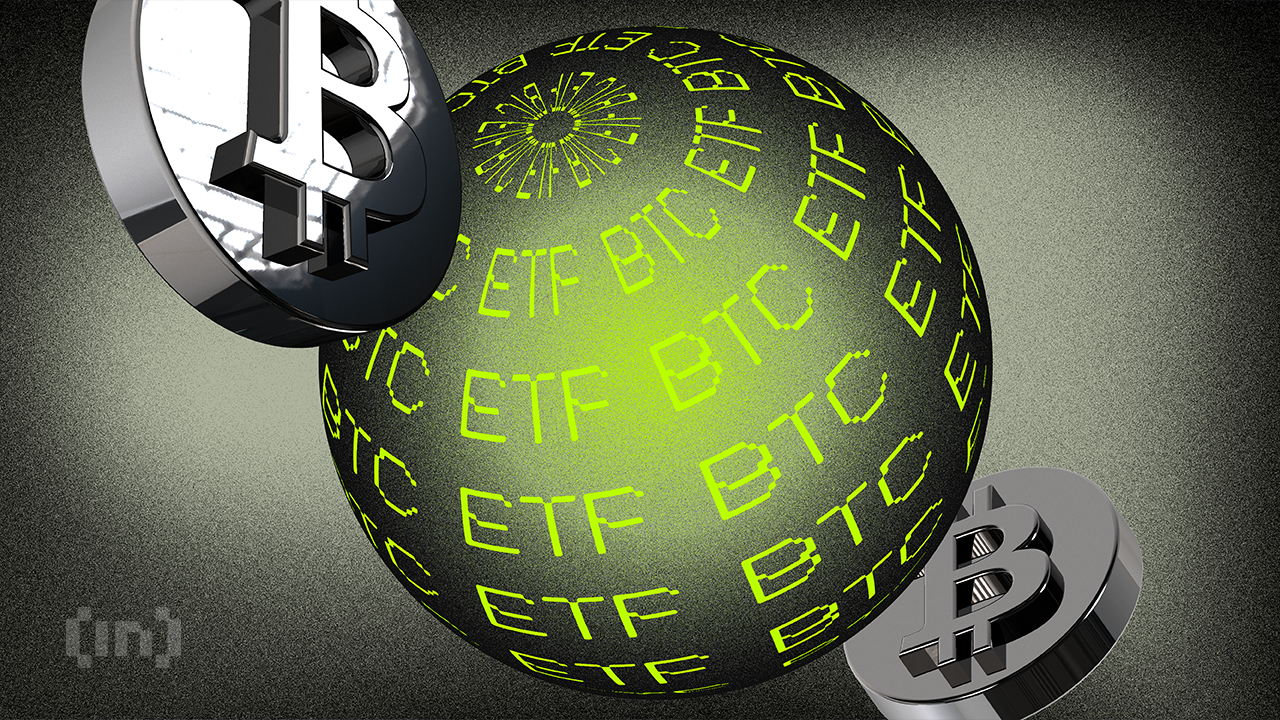
According to new data from Arkham Intelligence, three major Bitcoin ETF issuers are acquiring huge amounts of BTC today. The ETFs had $220 million in net inflows yesterday, and the issuers are potentially expecting a spike in demand.
Although Bitcoin has seen wild fluctuations over the past couple of days, institutional investors might show more confidence in the leading cryptocurrency than the TradFi market.
Why are ETF Issuers Buying Bitcoin?
The crypto market experienced wider liquidations today, and fears of a broader recession are circulating heavily. Since President Trump imposed much higher tariffs than expected, crypto is mirroring the TradFi stock market with notable downturns.
However, the US spot Bitcoin ETFs market shows that institutional demand might rebound in the short term.
“Donald Trump just tariffed the entire world. So? Grayscale is buying Bitcoin, Fidelity is buying Bitcoin, Ark Invest is buying Bitcoin,” Arkham Intelligence noted on social media.
Arkham Intelligence, a prominent blockchain analysis platform, is not the only one noticing this trend in Bitcoin ETFs. Although Bitcoin’s price has been very volatile over the last two days, it has consistently managed to return to a rough baseline.
The asset’s long-short ratio was 0.94 last week, and it shifted to 1 today. This signals a move toward more balanced investor positioning.
Previously, with 48.5% long positions against 51.5% short positions, the market exhibited a slight bearish tilt. Today, the equal split—with 50.5% long positions—signals that investors have neutralized their stance, reducing the bearish bias.

This balanced positioning suggests that market sentiment has stabilized, potentially reflecting increased uncertainty about near-term price movements. Bitcoin investors may now be awaiting clearer market signals before committing to a more directional bias.
Additionally, the Bitcoin ETFs have performed well in another key area. According to data from SoSo Value, the entire asset category had net inflows of $220 million yesterday.
Granted, Trump made his Liberation Day announcements after the stock market closed yesterday, but that’s still a very impressive amount of growth.
It is currently unclear exactly what impact today’s market turmoil had on the Bitcoin ETFs as an asset category. However, Arkham’s data suggests that these issuers are making notable investments in BTC.
If nothing else, it suggests that these firms are anticipating an uptick in demand in the near future. There are still many unanswered questions about tariffs, crypto markets, and the global economy as a whole.
If ETF inflows continue throughout this week, it will reflect institutional investors’ betting on BTC to remain more stable and sustainable than TradFi markets amid recession concerns.
Disclaimer
In adherence to the Trust Project guidelines, BeInCrypto is committed to unbiased, transparent reporting. This news article aims to provide accurate, timely information. However, readers are advised to verify facts independently and consult with a professional before making any decisions based on this content. Please note that our Terms and Conditions, Privacy Policy, and Disclaimers have been updated.
Bitcoin
BlackRock Approved by FCA to Operate as UK Crypto Asset Firm

BlackRock, the world’s largest asset manager, received approval from the UK’s Financial Conduct Authority (FCA) to operate as a crypto asset firm.
This marks a significant milestone for the investment giant, allowing it to extend its influence in the growing digital asset market.
BlackRock Joins Crypto Elite with FCA Approval in the UK
With this approval, BlackRock can operate its newly launched European Bitcoin exchange-traded product (ETP) as a UK entity.
According to the FCA’s website, BlackRock officially became the 51st company registered as a crypto asset firm on April 1, 2025. The firm joins a select group of financial entities, including Coinbase, PayPal, and Revolut, which have met the FCA’s stringent regulatory requirements.
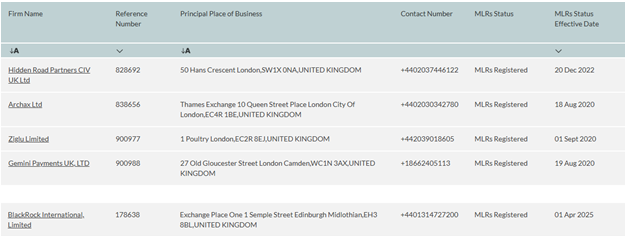
BlackRock’s iShares Bitcoin ETP recently launched on the Euronext stock exchanges in Paris and Amsterdam. As BeInCrypto reported, this marked an expansion of the firm’s footprint in the European crypto investment market.
To attract investors, the product was introduced with a temporary fee waiver. It reduced its expense ratio to 0.15% until the end of the year. Once the waiver expires, the fee will revert to 0.25%, aligning with competing products like CoinShares’ Bitcoin ETP.
The iShares Bitcoin ETP is designed for institutional and informed retail investors. It offers a regulated and cost-effective way to gain exposure to Bitcoin. This move also positions BlackRock as a leader in the European digital asset space, catering to the growing demand for crypto-based financial products.
Meanwhile, the FCA has faced criticism for its cautious approach to crypto regulation. It has only approved around 9% of all applicants seeking registration as crypto asset firms.
“This low level of application approval signifies potential concern for the UK’s ambition to become a crypto hub,” Alan Vey, founder of web3 firm Aventus and a former Brevan Howard developer, said recently.
The regulator has defended its strict policies. A statement on its website articulated that many submissions lack essential information or fail to meet compliance standards.
“We have rejected submissions that didn’t include key components necessary for us to carry out an assessment, or the poor quality of key components meant the submission was invalid,” the FCA wrote.
Therefore, BlackRock’s FCA approval is not a mean feat. It marks another step in the mainstream adoption of crypto. With the UK now part of BlackRock’s growing crypto asset operations, the firm continues to push forward in integrating Bitcoin into traditional finance (TradFi).
BlackRock also manages approximately $12 trillion in assets (AUM) and continues actively expanding its crypto market presence. It launched its iShares Bitcoin Trust (IBIT) in the US in January 2024. The financial instrument has since grown into the largest US spot Bitcoin ETF, managing nearly $49 billion in assets.
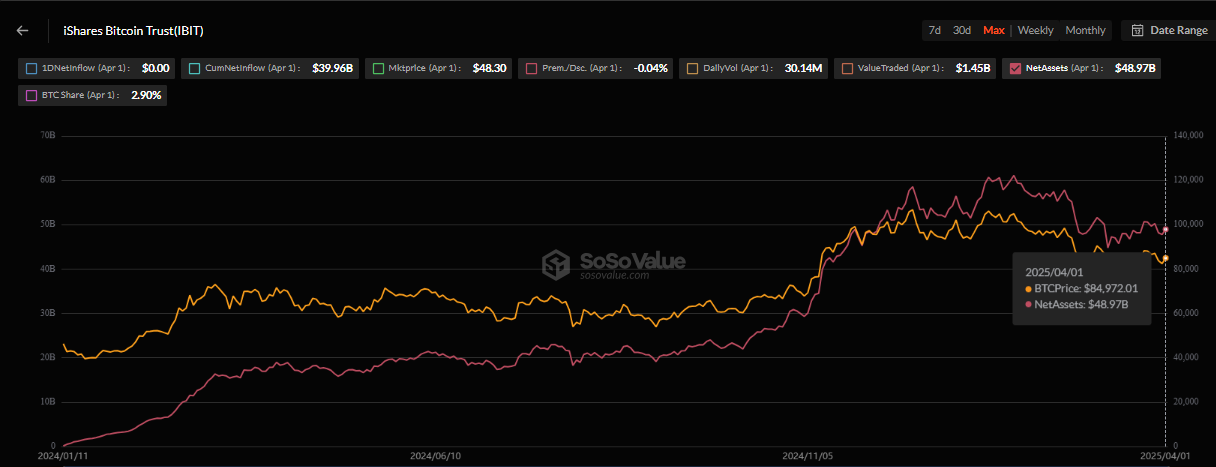
Moreover, the surge in institutional interest in Bitcoin ETFs has been remarkable. In just one year, US spot Bitcoin ETFs have attracted over $95 billion in investments, SoSoValue data shows. This highlights the increasing demand for regulated Bitcoin investment vehicles.
Disclaimer
In adherence to the Trust Project guidelines, BeInCrypto is committed to unbiased, transparent reporting. This news article aims to provide accurate, timely information. However, readers are advised to verify facts independently and consult with a professional before making any decisions based on this content. Please note that our Terms and Conditions, Privacy Policy, and Disclaimers have been updated.
Bitcoin
What It Means for Bitcoin

An expert has cautioned that the reverse yen carry trade is currently unfolding, albeit at a slower and more controlled pace.
This could have significant implications not only for traditional financial markets but also for cryptocurrencies like Bitcoin (BTC).
Why Investors Should Pay Attention to the Yen Carry Trade?
For context, the yen carry trade is a strategy in which investors borrow yen at low interest rates and invest the funds in higher-yielding assets, such as the US dollar or technology stocks. The goal is to profit from the difference in interest rates.
Nonetheless, this strategy’s risk arises from currency fluctuations. If the yen appreciates, investors converting the investment back to yen to repay the loan may see reduced or eliminated profits.
According to Michael A. Gayed, this scenario appears to be materializing now.
“The problem today is that those borrowing costs are starting to get more expensive. Traders who were able to access virtually free capital for years are now finding themselves sitting on costly margin positions that they’re potentially being forced to unwind,” he said.
In his recent report, Gayed explained that rising borrowing costs compel traders to offload dollar-denominated assets. This, in turn, heightens market volatility and depresses the prices of risk assets.
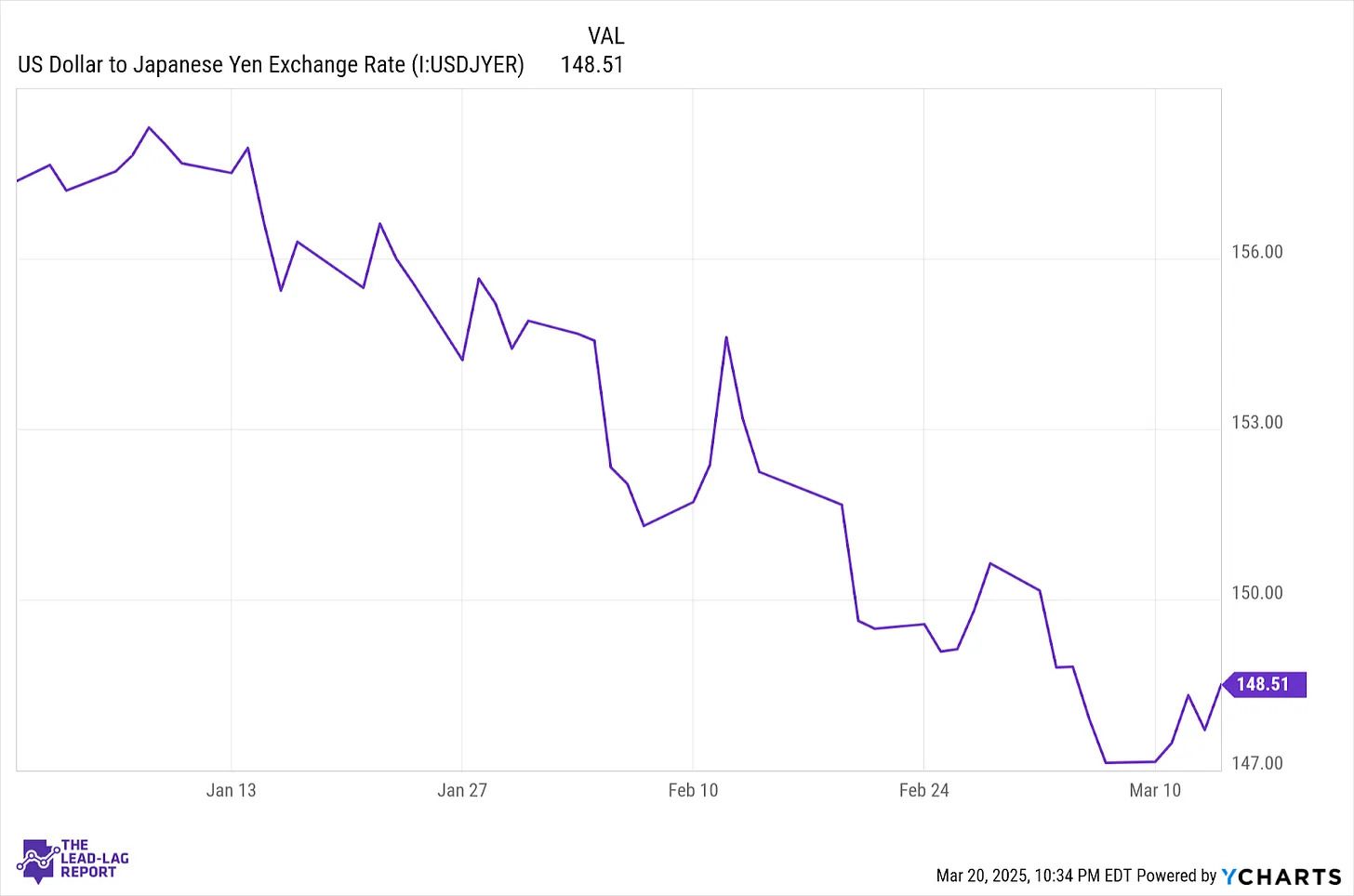
Notably, this happened last year as well. Gayed pointed out that in August 2024, the Bank of Japan’s decision to raise interest rates twice sparked a significant rally in the yen. Yet, at the same time, the S&P 500 saw an approximate 10% correction.
He added that the subsequent rebound alleviated investor concerns. Nevertheless, he believes the real issue is that the situation was never fully resolved.
“Big carry trade unwinds don’t just last a couple of weeks, and conditions are suddenly normalized,” Gayed stressed.
He added that the current market conditions resemble a similar situation. Notably, the Japanese 10-year yield has surged to 1.56%, the highest since 2008. As these yields climb, the yen strengthens, and the carry trade dynamics begin to shift.
“The 10-year yield continues to climb higher and close the interest rate differential on comparable 10-year US Treasury yields. That’s going to continue fueling strength in the yen that may continue into the later stages of 2025. And as long as the yen continues to strengthen, whether it’s quickly and slowly, that’s going to keep unwinding any outstanding carry trade that’s still out there. And it’s probably a lot,” he stated.
Moreover, Gayed suggested that the Bank of Japan will likely continue raising rates. Meanwhile, the Fed might possibly lower them in the coming months, further solidifying his outlook.
He also focused on the correlation between the S&P 500 and the yen. Gayed noted that the yen’s rise preceded the recent S&P 500 pullback by several weeks.
The correction could also be linked to an anticipated US growth slowdown and potential tariffs. Yet, he emphasized that the reverse carry trade is particularly risky due to its potential to escalate quickly, especially in the current macroeconomic climate.
“The market is plenty capable of correcting on its own, given the fears associated with tariffs and slowing economic growth. If you add people being forced to sell their US equity holdings in order to close out their short yen positions on top of that, it’s easy to see how a bad situation quickly becomes worse. And it’s already happening. Japan is still the real risk,” he claimed.
Now, the question is, why will this impact Bitcoin? Given its close correlation with the S&P 500, a correction in the latter could spell trouble for BTC. Analyst Lark Davis pointed out that Bitcoin and the S&P 500 have been closely linked since 2023.
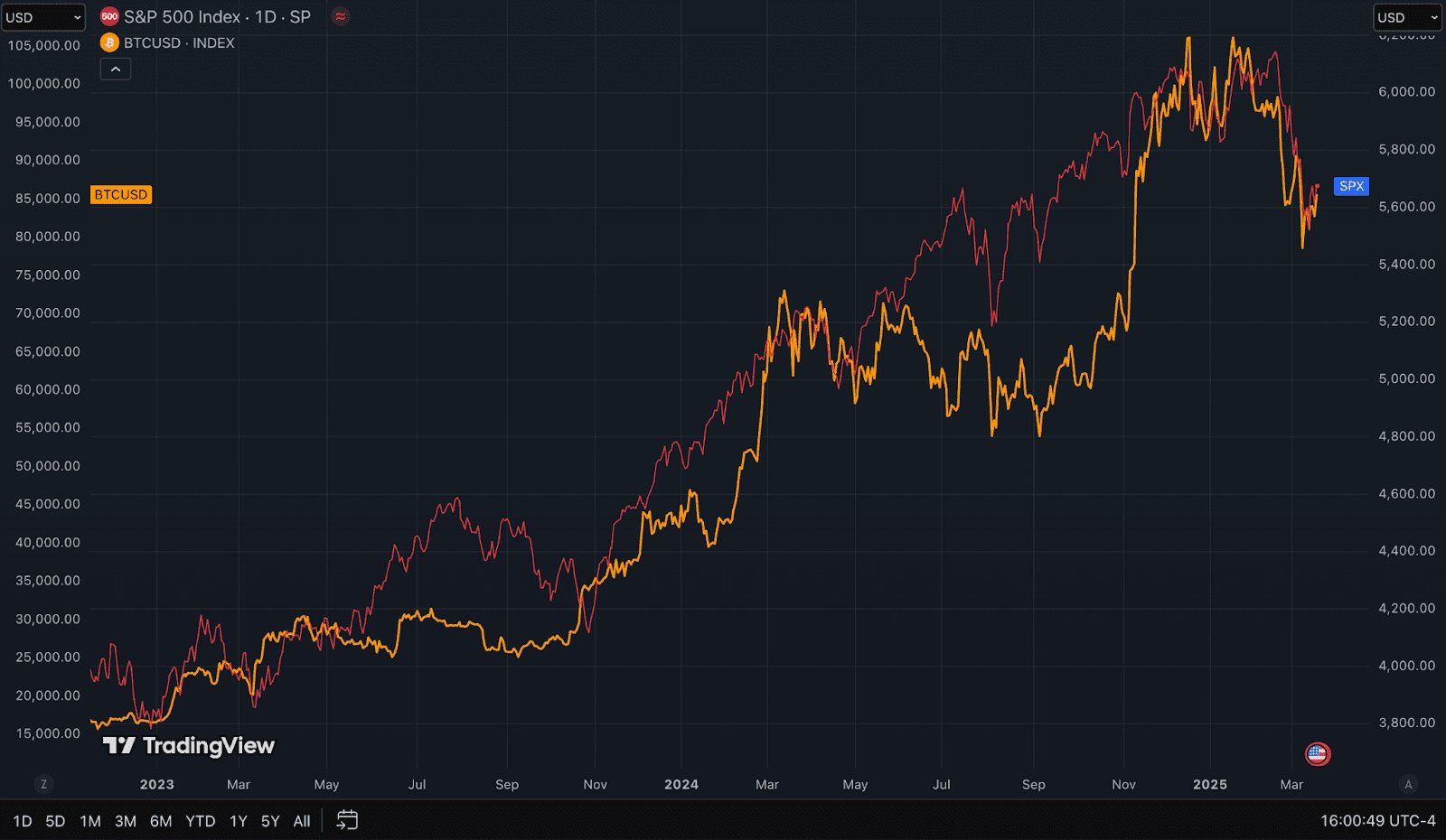
“So as we’re trying to determine where Bitcoin goes from here, the unfortunate truth is that it all probably depends on what happens to the major stock indices,” he noted
Davis also advised crypto investors to monitor the broader economy, the stock market, and the M2 money supply, both in the US and globally.
For now, the largest cryptocurrency continues to navigate volatility ahead of President Trump’s tariff announcement. In fact, BeInCrypto reported that spot Bitcoin ETFs have recorded outflows for three consecutive days.

On the price front, Bitcoin has dipped 3.1% over the past week. At press time, the coin was trading at $85,042, representing small gains of 0.8% over the past day.
Disclaimer
In adherence to the Trust Project guidelines, BeInCrypto is committed to unbiased, transparent reporting. This news article aims to provide accurate, timely information. However, readers are advised to verify facts independently and consult with a professional before making any decisions based on this content. Please note that our Terms and Conditions, Privacy Policy, and Disclaimers have been updated.
-

 Market20 hours ago
Market20 hours agoIP Token Price Surges, but Weak Demand Hints at Reversal
-

 Market23 hours ago
Market23 hours agoEthereum Price Recovery Stalls—Bears Keep Price Below $2K
-

 Altcoin21 hours ago
Altcoin21 hours agoBinance Issues Key Announcement On StakeStone TGE; Here’s All
-

 Altcoin20 hours ago
Altcoin20 hours agoMovimiento millonario de Solana, SOLX es la mejor opción
-

 Ethereum19 hours ago
Ethereum19 hours agoEthereum Trading In ‘No Man’s Land’, Breakout A ‘Matter Of Time’?
-
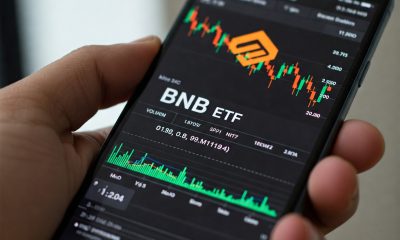
 Altcoin22 hours ago
Altcoin22 hours agoVanEck Seeks BNB ETF Approval—Big Win For Binance?
-

 Market16 hours ago
Market16 hours agoBitcoin’s Future After Trump Tariffs
-

 Bitcoin20 hours ago
Bitcoin20 hours agoWhat It Means for Bitcoin






